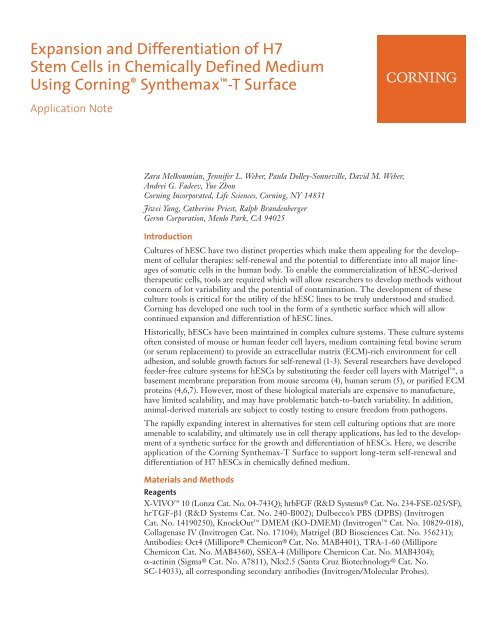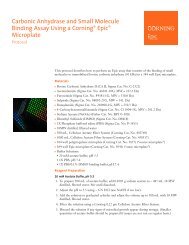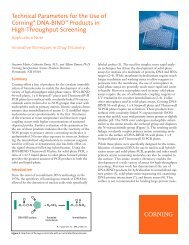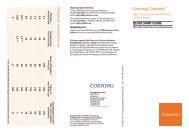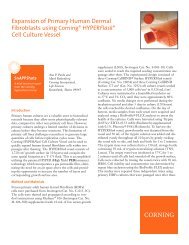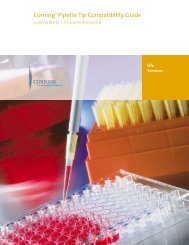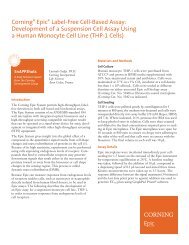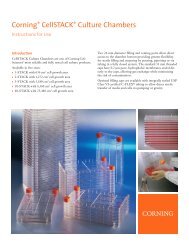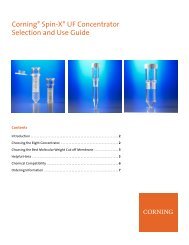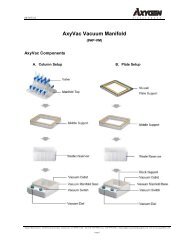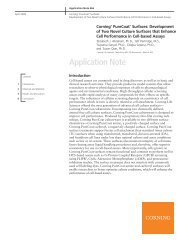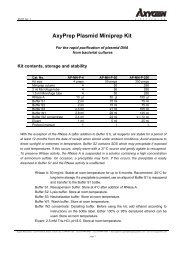Expansion and Differentiation of H7 Stem Cells in Chemically ...
Expansion and Differentiation of H7 Stem Cells in Chemically ...
Expansion and Differentiation of H7 Stem Cells in Chemically ...
Create successful ePaper yourself
Turn your PDF publications into a flip-book with our unique Google optimized e-Paper software.
<strong>Expansion</strong> <strong>and</strong> <strong>Differentiation</strong> <strong>of</strong> <strong>H7</strong><br />
<strong>Stem</strong> <strong>Cells</strong> <strong>in</strong> <strong>Chemically</strong> Def<strong>in</strong>ed Medium<br />
Us<strong>in</strong>g Corn<strong>in</strong>g ® Synthemax -T Surface<br />
Application Note<br />
Zara Melkoumian, Jennifer L. Weber, Paula Dolley-Sonneville, David M. Weber,<br />
Andrei G. Fadeev, Yue Zhou<br />
Corn<strong>in</strong>g Incorporated, Life Sciences, Corn<strong>in</strong>g, NY 14831<br />
Jiwei Yang, Cather<strong>in</strong>e Priest, Ralph Br<strong>and</strong>enberger<br />
Geron Corporation, Menlo Park, CA 94025<br />
Introduction<br />
Cultures <strong>of</strong> hESC have two dist<strong>in</strong>ct properties which make them appeal<strong>in</strong>g for the development<br />
<strong>of</strong> cellular therapies: self-renewal <strong>and</strong> the potential to differentiate <strong>in</strong>to all major l<strong>in</strong>eages<br />
<strong>of</strong> somatic cells <strong>in</strong> the human body. To enable the commercialization <strong>of</strong> hESC-derived<br />
therapeutic cells, tools are required which will allow researchers to develop methods without<br />
concern <strong>of</strong> lot variability <strong>and</strong> the potential <strong>of</strong> contam<strong>in</strong>ation. The development <strong>of</strong> these<br />
culture tools is critical for the utility <strong>of</strong> the hESC l<strong>in</strong>es to be truly understood <strong>and</strong> studied.<br />
Corn<strong>in</strong>g has developed one such tool <strong>in</strong> the form <strong>of</strong> a synthetic surface which will allow<br />
cont<strong>in</strong>ued expansion <strong>and</strong> differentiation <strong>of</strong> hESC l<strong>in</strong>es.<br />
Historically, hESCs have been ma<strong>in</strong>ta<strong>in</strong>ed <strong>in</strong> complex culture systems. These culture systems<br />
<strong>of</strong>ten consisted <strong>of</strong> mouse or human feeder cell layers, medium conta<strong>in</strong><strong>in</strong>g fetal bov<strong>in</strong>e serum<br />
(or serum replacement) to provide an extracellular matrix (ECM)-rich environment for cell<br />
adhesion, <strong>and</strong> soluble growth factors for self-renewal (1-3). Several researchers have developed<br />
feeder-free culture systems for hESCs by substitut<strong>in</strong>g the feeder cell layers with Matrigel , a<br />
basement membrane preparation from mouse sarcoma (4), human serum (5), or purified ECM<br />
prote<strong>in</strong>s (4,6,7). However, most <strong>of</strong> these biological materials are expensive to manufacture,<br />
have limited scalability, <strong>and</strong> may have problematic batch-to-batch variability. In addition,<br />
animal-derived materials are subject to costly test<strong>in</strong>g to ensure freedom from pathogens.<br />
The rapidly exp<strong>and</strong><strong>in</strong>g <strong>in</strong>terest <strong>in</strong> alternatives for stem cell cultur<strong>in</strong>g options that are more<br />
amenable to scalability, <strong>and</strong> ultimately use <strong>in</strong> cell therapy applications, has led to the development<br />
<strong>of</strong> a synthetic surface for the growth <strong>and</strong> differentiation <strong>of</strong> hESCs. Here, we describe<br />
application <strong>of</strong> the Corn<strong>in</strong>g Synthemax-T Surface to support long-term self-renewal <strong>and</strong><br />
differentiation <strong>of</strong> <strong>H7</strong> hESCs <strong>in</strong> chemically def<strong>in</strong>ed medium.<br />
Materials <strong>and</strong> Methods<br />
Reagents<br />
X-VIVO 10 (Lonza Cat. No. 04-743Q); hrbFGF (R&D Systems ® Cat. No. 234-FSE-025/SF),<br />
hrTGF-β1 (R&D Systems Cat. No. 240-B002); Dulbecco’s PBS (DPBS) (Invitrogen<br />
Cat. No. 14190250), KnockOut DMEM (KO-DMEM) (Invitrogen Cat. No. 10829-018),<br />
Collagenase IV (Invitrogen Cat. No. 17104); Matrigel (BD Biosciences Cat. No. 356231);<br />
Antibodies: Oct4 (Millipore ® Chemicon ® Cat. No. MAB4401), TRA-1-60 (Millipore<br />
Chemicon Cat. No. MAB4360), SSEA-4 (Millipore Chemicon Cat. No. MAB4304);<br />
α-act<strong>in</strong><strong>in</strong> (Sigma ® Cat. No. A7811), Nkx2.5 (Santa Cruz Biotechnology ® Cat. No.<br />
SC-14033), all correspond<strong>in</strong>g secondary antibodies (Invitrogen/Molecular Probes).
hESC Culture<br />
<strong>H7</strong> hESCs were provided by Geron Corporation under collaborative agreement. The cells<br />
were ma<strong>in</strong>ta<strong>in</strong>ed <strong>in</strong> chemically def<strong>in</strong>ed xeno-free medium (X-VIVO 10 basal medium supplemented<br />
with 80 ng/mL human recomb<strong>in</strong>ant (hrbFGF) <strong>and</strong> 0.5 ng/mL human recomb<strong>in</strong>ant<br />
TGFβ (hrTGF-β) accord<strong>in</strong>g to the protocol for hESC culture on Corn<strong>in</strong>g ® Synthemax -T<br />
Surface (CLS-AN-148). Cultures were briefly passaged every 4 to 6 days. Once the cells<br />
approached 80% confluency, they were detached by <strong>in</strong>cubation with 200 U/mL collagenase<br />
IV for 2 to 3 m<strong>in</strong>utes, followed by a brief wash with DBPS <strong>and</strong> gentle scrap<strong>in</strong>g. For each<br />
passage, <strong>H7</strong> cells were subcultured <strong>in</strong>to 6 well Corn<strong>in</strong>g Synthemax-T Surface plates <strong>and</strong><br />
Matrigel (1:30 dilution <strong>in</strong> KO-DMEM) coated Corn<strong>in</strong>g tissue culture treated plates<br />
(Corn<strong>in</strong>g Cat. No. 3506) at the density <strong>of</strong> 100,000 cell/cm 2 <strong>in</strong> chemically def<strong>in</strong>ed medium<br />
described above. Culture medium was replaced every day except for the day after passage.<br />
Microscopic exam<strong>in</strong>ation <strong>of</strong> cell <strong>and</strong> colony morphology was performed daily. Cell viability<br />
<strong>and</strong> number were assessed at each passage by harvest<strong>in</strong>g duplicate wells with collagenase<br />
IV/EDTA treatment followed by cell count<strong>in</strong>g with an automated cell number/viability<br />
analyzer, Vi-Cell (Beckman Coulter). Expression <strong>of</strong> hESC-specific markers was assessed<br />
by flow cytometry <strong>and</strong> immun<strong>of</strong>luorescent sta<strong>in</strong><strong>in</strong>g at the end <strong>of</strong> each passage for >10 serial<br />
passages. To monitor genomic <strong>in</strong>tegrity, cell samples were submitted for karyotyp<strong>in</strong>g analysis<br />
by G-b<strong>and</strong><strong>in</strong>g (Cytogenetics Laboratories, Children’s Hospital, Oakl<strong>and</strong>, CA) at passages 0,<br />
5, <strong>and</strong> 10 on Corn<strong>in</strong>g Synthemax-T Surface.<br />
Teratoma Formation Assay<br />
Cell pluripotency was assessed by teratoma formation assay. After 10 passages on Corn<strong>in</strong>g<br />
Synthemax-T Surface <strong>and</strong> Matrigel surface, <strong>H7</strong> cells were harvested <strong>and</strong> resuspended <strong>in</strong> PBS<br />
at the concentration <strong>of</strong> 1x10 5 cells/mL. Prior to each <strong>in</strong>jection, 100 mL <strong>of</strong> cells was mixed<br />
with 100 mL <strong>of</strong> Matrigel. The mixture was immediately <strong>in</strong>jected <strong>in</strong>to a h<strong>in</strong>d limb muscle<br />
<strong>of</strong> SCID/bg mice. Each group (Corn<strong>in</strong>g Synthemax-T Surface <strong>and</strong> Matrigel) conta<strong>in</strong>ed 8<br />
animals. The animals were term<strong>in</strong>ated case by case, depend<strong>in</strong>g on the visible masses <strong>in</strong> the<br />
muscle. The masses were fixed <strong>in</strong> situ us<strong>in</strong>g 10% neutral formal<strong>in</strong> <strong>and</strong> paraff<strong>in</strong> embedded<br />
us<strong>in</strong>g st<strong>and</strong>ard histological methods. Sections were cut at 5 to 8 µm <strong>and</strong> sta<strong>in</strong>ed us<strong>in</strong>g<br />
hematoxyl<strong>in</strong> <strong>and</strong> eos<strong>in</strong>. Tissues were exam<strong>in</strong>ed under brightfield optics us<strong>in</strong>g a ZEISS ®<br />
Axioskop 2 Plus photomicroscope (Carl Zeiss, Inc., Göttigen, Germany) <strong>and</strong> digital<br />
microscopy images were captured us<strong>in</strong>g a Pixera ® Pengu<strong>in</strong> 600CL digital camera (Pixera<br />
Corporation, Los Gatos, CA). Digital images <strong>in</strong> Figure 5 were sized <strong>and</strong> balanced for<br />
brightness <strong>and</strong> contrast us<strong>in</strong>g Photoshop ® version 7.0.1 (Adobe Systems, San Jose, CA); no<br />
additional digital image manipulation was performed.<br />
Cardiomyocyte <strong>Differentiation</strong><br />
<strong>H7</strong> hESCs were differentiated on the Corn<strong>in</strong>g Synthemax-T Surface for approximately 25 to<br />
30 days us<strong>in</strong>g a direct differentiation protocol described by Laflamme, M.A. et al. (8). Briefly,<br />
undifferentiated <strong>H7</strong> hESCs were cultured on Synthemax-T Surface <strong>in</strong> serum replacement<br />
medium (SRM: KnockOut DMEM + 20% KnockOut SR, 1 mM L-glutam<strong>in</strong>e, 1% NEAA,<br />
0.1 mM 2-ME, 80 ng/mL hrbFGF, 0.5 ng/mL hrTGFb1) for one week (adaptation phase)<br />
prior to sub-cultivation onto Synthemax-T Surface at the density <strong>of</strong> 100,000 cell/cm 2 . <strong>Cells</strong><br />
were re-fed daily with SRM for 6 days. Cardiac differentiation was <strong>in</strong>duced by sequential<br />
exposure <strong>of</strong> cells to 100 ng/mL <strong>of</strong> activ<strong>in</strong> A for 24 hours, followed by 10 ng/mL BMP4 for<br />
4 days <strong>in</strong> RPMI-B27 medium. <strong>Cells</strong> were re-fed every 2 to 3 days with RPMI-B27 medium<br />
without growth factors for additional 2 to 3 weeks. Widespread spontaneous beat<strong>in</strong>g activity<br />
was typically observed by 12 days post-activ<strong>in</strong> A <strong>in</strong>duction. Cardiomyocyte differentiation<br />
was assessed by look<strong>in</strong>g for specific markers (α-act<strong>in</strong><strong>in</strong>, Nkx2.5) us<strong>in</strong>g immun<strong>of</strong>luorescent<br />
sta<strong>in</strong><strong>in</strong>g.<br />
2
Results <strong>and</strong> Discussion<br />
Corn<strong>in</strong>g ® Synthemax-T Surface Supports Self-renewal <strong>of</strong> hESCs for >10 Serial Passages <strong>in</strong><br />
Xeno-free, Def<strong>in</strong>ed Medium<br />
Historically, the viability <strong>of</strong> a culture system to support hESC growth has been evaluated<br />
by determ<strong>in</strong><strong>in</strong>g whether or not the culture system can support >5 serial passages on the cell<br />
l<strong>in</strong>e. Therefore, the Corn<strong>in</strong>g Synthemax-T Surface was evaluated with <strong>H7</strong> hESCs by serial<br />
passag<strong>in</strong>g as described <strong>in</strong> the Methods section above. Figure 1 demonstrates expansion <strong>of</strong> <strong>H7</strong><br />
hESCs for 12 serial passages on Corn<strong>in</strong>g Synthemax-T Surface <strong>and</strong> compares the results to<br />
one <strong>of</strong> the feeder-free culture systems that <strong>in</strong>corporates the use <strong>of</strong> a Matrigel biological surface.<br />
<strong>Cells</strong> passages on the Corn<strong>in</strong>g Synthemax-T Surface demonstrated very stable doubl<strong>in</strong>g<br />
time on average <strong>of</strong> 41 ± 5 hours, <strong>in</strong>dicative <strong>of</strong> a consistent culture environment. Cell doubl<strong>in</strong>g<br />
time for cultures passaged <strong>in</strong> parallel on Matrigel coated surface exhibited much higher<br />
variability (average doubl<strong>in</strong>g time <strong>of</strong> 50 ± 12 hours), probably due <strong>in</strong> part to the <strong>in</strong>herent<br />
variability <strong>of</strong> this surface coated with a biological material.<br />
In order to evaluate whether or not serial passage on the Corn<strong>in</strong>g Synthemax-T Surface supported<br />
the propagation <strong>of</strong> hESCs <strong>in</strong> their undifferentiated state, the cells were evaluated for<br />
the expression <strong>of</strong> the hESC phenotypic markers, Oct4 <strong>and</strong> SSEA4. Oct4 is a nuclear transcription<br />
factor <strong>and</strong> SSEA4 <strong>and</strong> TRA-1-60 are surface markers, which are typically expressed<br />
<strong>in</strong> undifferentiated hESCs. Dur<strong>in</strong>g 11 serial passages on the Corn<strong>in</strong>g Synthemax-T Surface,<br />
<strong>H7</strong> cells reta<strong>in</strong>ed high expression levels <strong>of</strong> hESC phenotypic markers Oct4, TRA-1-60 <strong>and</strong><br />
SSEA4, as shown by flow cytometry analysis for Oct4 marker (Figure 2) <strong>and</strong> immun<strong>of</strong>lorescent<br />
sta<strong>in</strong><strong>in</strong>g for Oct4, TRA-1-60 <strong>and</strong> SSEA4 (Figure 3), respectively. These results confirm<br />
the undifferentiated status <strong>of</strong> <strong>H7</strong> hESCs after serial passag<strong>in</strong>g on the Corn<strong>in</strong>g<br />
Synthemax-T Surface <strong>in</strong> chemically def<strong>in</strong>ed medium.<br />
Typically, when cultur<strong>in</strong>g hESC l<strong>in</strong>es, karyotypic analyses are frequently recommended to<br />
ensure there is no acquisition <strong>of</strong> gross chromosomal abnormalities. Therefore, the karyotype<br />
for the <strong>H7</strong> hESCs was evaluated. Importantly, no genetic abnormalities were associated with<br />
hESC propagation on Corn<strong>in</strong>g Synthemax-T Surface, <strong>and</strong> cells reta<strong>in</strong>ed normal karyotype<br />
after 10 passages on Corn<strong>in</strong>g Synthemax-T Surface (Figure 4).<br />
100<br />
Doubl<strong>in</strong>g Time (hours)<br />
80<br />
60<br />
40<br />
20<br />
Corn<strong>in</strong>g Synthemax Surface<br />
Matrigel<br />
0<br />
0 1 2 3 4 5 6 7 8 9 10 11 12 13<br />
Passage Number<br />
Figure 1. Long-term culture <strong>of</strong> <strong>H7</strong> hESCs on Corn<strong>in</strong>g Synthemax-T Surface <strong>in</strong> def<strong>in</strong>ed, xeno-free medium. Doubl<strong>in</strong>g<br />
time <strong>of</strong> <strong>H7</strong> cells over the course <strong>of</strong> 12 serial passages on Matrigel <strong>and</strong> Corn<strong>in</strong>g Synthemax-T Surface. Average<br />
doubl<strong>in</strong>g time for CCorn<strong>in</strong>g Synthemax-T Surface was 41 ±<br />
M<br />
5 hours, for Matrigel surface 50 ± 12 hours.<br />
3
C<br />
These results suggest that <strong>H7</strong> hESC can be successfully propagated on Corn<strong>in</strong>g ® Synthemax -T<br />
Surface for multiple passages <strong>in</strong> xeno-free, def<strong>in</strong>ed medium, while reta<strong>in</strong><strong>in</strong>g important<br />
hESC characteristics such as stable proliferation rate, phenotypic marker pr<strong>of</strong>ile <strong>and</strong> normal<br />
karyotype.<br />
hESCs Reta<strong>in</strong> Pluripotency After 10 Serial Passages on Corn<strong>in</strong>g Synthemax-T Surface<br />
A fundamental property <strong>of</strong> hESCs is their ability to differentiate <strong>in</strong>to cells <strong>of</strong> all three germ<br />
layers. Ma<strong>in</strong>ta<strong>in</strong><strong>in</strong>g this property is a critical parameter when evaluat<strong>in</strong>g the use <strong>of</strong> new culture<br />
conditions for hESC culture. Therefore, we exam<strong>in</strong>ed whether <strong>H7</strong> hESCs ma<strong>in</strong>ta<strong>in</strong>ed<br />
on Corn<strong>in</strong>g Synthemax-T Surface reta<strong>in</strong>ed their ability to differentiate <strong>in</strong>to cells <strong>of</strong> all<br />
three germ layers us<strong>in</strong>g an <strong>in</strong> vivo differentiation assay (teratoma formation <strong>in</strong> mice). Figure 5<br />
P<br />
120<br />
Oct4 Positive <strong>Cells</strong> (% <strong>of</strong> total)<br />
100<br />
80<br />
60<br />
40<br />
20<br />
Corn<strong>in</strong>g Synthemax Surface<br />
Matrigel<br />
0<br />
1 2 3 4 5 6 7 8 9 10 11<br />
Passage Number<br />
Figure 2. Flow cytometry analysis <strong>of</strong> Oct4 phenotypic marker expression <strong>in</strong> <strong>H7</strong> cells dur<strong>in</strong>g 11 serial passages on<br />
Corn<strong>in</strong>g Synthemax-T Surface.<br />
Oct4 TRA-1-60 SSEA4<br />
Hoechst Hoechst Hoechst<br />
4<br />
Figure 3. Immun<strong>of</strong>luorescent sta<strong>in</strong><strong>in</strong>g <strong>of</strong> phenotypic markers <strong>in</strong> <strong>H7</strong> cells after 10 serial passages on Corn<strong>in</strong>g<br />
Synthemax-T Surface. Indirect immun<strong>of</strong>luorescent sta<strong>in</strong><strong>in</strong>g <strong>of</strong> <strong>H7</strong> cells for Oct4, TRA-1-60 <strong>and</strong> SSEA4 markers after<br />
10 serial passages on Corn<strong>in</strong>g Synthemax-T Surface. Hoechst nuclear sta<strong>in</strong><strong>in</strong>g was used to show the entire cell<br />
population. Scale bar: 100 µM.
shows positive sta<strong>in</strong><strong>in</strong>g for representative tissues from all three germ layers (secretory epithelium,<br />
bone <strong>and</strong> melanocytes) <strong>in</strong> teratomas developed after <strong>in</strong>jection <strong>of</strong> mice with <strong>H7</strong> cells<br />
cultured on Corn<strong>in</strong>g ® Synthemax-T Surface <strong>and</strong> Matrigel coated surface for 10 serial<br />
passages. This data confirms retention <strong>of</strong> pluripotency <strong>of</strong> <strong>H7</strong> cells after long-term culture on<br />
Corn<strong>in</strong>g Synthemax-T Surface <strong>in</strong> def<strong>in</strong>ed medium (Figure 5).<br />
<strong>Differentiation</strong> <strong>of</strong> <strong>H7</strong> hESC <strong>in</strong>to Cardiomyocytes After Long-term Culture on<br />
Corn<strong>in</strong>g Synthemax-T Surface<br />
For therapeutic applications <strong>of</strong> hESC it is highly desirable to have def<strong>in</strong>ed culture conditions<br />
for both the expansion <strong>and</strong> differentiation phase <strong>of</strong> therapeutic cell production. Therefore,<br />
the <strong>H7</strong> hESCs passages <strong>and</strong> exp<strong>and</strong>ed on the Corn<strong>in</strong>g Synthemax-T Surface sequentially<br />
exposed to the appropriate cytok<strong>in</strong>es as described <strong>in</strong> Methods to stimulate differentiation<br />
<strong>in</strong>to cardiomyocytes. As demonstrated by immun<strong>of</strong>luorescent sta<strong>in</strong><strong>in</strong>g <strong>in</strong> Figure 6, Corn<strong>in</strong>g<br />
Synthemax-T Surface supports differentiation <strong>of</strong> <strong>H7</strong> hESCs <strong>in</strong>to functional cardiomyocytes,<br />
express<strong>in</strong>g cardiomyocytes specific markers α-act<strong>in</strong><strong>in</strong> <strong>and</strong> Nkx2.5. Additional quantitative<br />
assessment <strong>of</strong> differentiation was performed by flow cytometry analysis <strong>of</strong> α-act<strong>in</strong><strong>in</strong>positive<br />
cell fraction. This analysis confirmed up to 83% <strong>of</strong> cells differentiated on Corn<strong>in</strong>g<br />
Synthemax-T Surface express α-act<strong>in</strong><strong>in</strong> marker, suggest<strong>in</strong>g high purity <strong>of</strong> cardiomyocytes<br />
differentiation on Corn<strong>in</strong>g Synthemax-T Surface (data not shown). These results suggest<br />
that Corn<strong>in</strong>g Synthemax-T Surface can support directed differentiation <strong>of</strong> <strong>H7</strong> cells <strong>in</strong>to<br />
functional cardiomyocytes, therefore provid<strong>in</strong>g a synthetic surface solution for both<br />
expansion <strong>and</strong> differentiation phases <strong>of</strong> hESC culture (Figure 6).<br />
Figure 4. <strong>H7</strong> cells reta<strong>in</strong>ed normal karyotype after long-term culture on Corn<strong>in</strong>g Synthemax-T Surface. Cytogenetic<br />
analysis revealed normal karyotype for <strong>H7</strong> cells cultured on Corn<strong>in</strong>g Synthemax-T Surface for 10 serial passages.<br />
5
Conclusion<br />
<strong>H7</strong> hESCs were successfully cultured for >10 serial passages on Corn<strong>in</strong>g ® Synthemax-T <br />
Surface us<strong>in</strong>g chemically def<strong>in</strong>ed, xeno-free medium. Throughout this long-term culture on<br />
Corn<strong>in</strong>g Synthemax-T Surface, cells demonstrated not only a stable doubl<strong>in</strong>g time <strong>of</strong> 41<br />
± 5 hours, but also a high level <strong>of</strong> expression <strong>of</strong> hESC phenotypic markers (Oct4, SSEA4 <strong>and</strong><br />
TRA-1-60) <strong>and</strong> normal karyotype. Cell pluripotency was confirmed by teratoma formation<br />
<strong>in</strong> mice. In addition, Corn<strong>in</strong>g Synthemax-T Surface supported successful directed differentiation<br />
<strong>of</strong> <strong>H7</strong> cells <strong>in</strong>to functional cardiomyocytes, prov<strong>in</strong>g suitability <strong>of</strong> Corn<strong>in</strong>g Synthemax-T<br />
Surface for both expansion <strong>and</strong> differentiation <strong>of</strong> hESC culture.<br />
Secretory epithelium Bone Melanocytes<br />
Matrigel<br />
Synthemax-T Surface<br />
Figure 5. <strong>H7</strong> cells reta<strong>in</strong>ed pluripotency after long-term culture on Corn<strong>in</strong>g Synthemax-T Surface. Teratoma<br />
formation <strong>in</strong> mice after <strong>in</strong>jection <strong>of</strong> <strong>H7</strong> hESC exp<strong>and</strong>ed on Corn<strong>in</strong>g Synthemax-T Surface <strong>and</strong> Matrigel surfaces<br />
for 10 serial passages. All three germ layers, represented as secretory epithelium (endoderm), bone (mesoderm)<br />
<strong>and</strong> melanocytes (ectoderm), were demonstrated by H&E sta<strong>in</strong><strong>in</strong>g. Scale bar: 50 µm.<br />
Figure 6. Directed differentiation<br />
<strong>of</strong> <strong>H7</strong> hESCs <strong>in</strong>to cardiomyocytes<br />
on Corn<strong>in</strong>g Synthemax-T Surface.<br />
Confocal fluorescent image <strong>of</strong><br />
beat<strong>in</strong>g structures immunosta<strong>in</strong>ed<br />
for cardiomyocyte-specific markers,<br />
Nkx2.5 (red), α-act<strong>in</strong><strong>in</strong> (green).<br />
6
References<br />
1. Thomson, J.A., Itskovitz-Eldor, J., Shapiro, S.S., Waknitz, M.A., Swiergiel, J.J., Marahall, V.S. et al.<br />
Embryonic stem cell l<strong>in</strong>es derived from human blatocysts. Science 282, 1145-1147 (1998).<br />
2. Amit, M., Margulets, V., Segev, H., Shariki, K., Laevsky, I., Coleman, R., <strong>and</strong> Itskovitz-Eldor, J.<br />
Human feeder layers for human embryonic stem cells. Biol. Reprod. 68, 2150-2156 (2003).<br />
3. Richards, M., Tan, S., Fong, C.Y., Biswas, A., Chan, W.K., Bongso, A. Comparative evaluation <strong>of</strong><br />
various human feeders for prolonged undifferentiated growth <strong>of</strong> human embryonic stem cells. <strong>Stem</strong><br />
<strong>Cells</strong> 21, 546-556 (2003).<br />
4. Xu, C., Inokuma, M.S., Denham, J., Golds, K., Kundu, P., Gold, J.D., Carpenter, M.K. Feeder-free<br />
growth <strong>of</strong> undifferentiated human embryonic stem cells. Nat Biotechnology 19, 971-974 (2001).<br />
5. Stojkovic, P., Lako, M., Przyborski, S., Stewart, R., Armstrong, L., Evans, J. et al. Human-serum<br />
matrix supports undifferentiated growth <strong>of</strong> human embryonic stem cells. <strong>Stem</strong> <strong>Cells</strong> 23, 895-902<br />
(2005).<br />
6. Lu, J., Hou, R., Booth, C.J., Yang, S.H., Snyder, M. Def<strong>in</strong>ed culture conditions <strong>of</strong> human embryonic<br />
stem cells. PNAS 103, 5688-5693 (2006).<br />
7. Li, Y., Powell, S., Brunette, E., Lebkowski, J., M<strong>and</strong>alam, R. <strong>Expansion</strong> <strong>of</strong> human embryonic stem<br />
cells <strong>in</strong> def<strong>in</strong>ed serum-free medium devoid <strong>of</strong> animal-derived products. Biotechnol Bioeng 91(6),<br />
688-98 (2005).<br />
8. 18.Laflamme, M.A., Chen, K.Y., Naumova, A.V., Muskheli, V., Fugate, J.A., Dupras, S.K., Re<strong>in</strong>ecke,<br />
H., Xu, C. et al. Cardiomyocytes derived from human embryonic stem cells <strong>in</strong> pro-survival factors<br />
enhance function <strong>of</strong> <strong>in</strong>farcted rat hearts. Nat Biotech 25(9), 1015-24 (2007).<br />
9. Melkoumian, Z. et. al. Synthetic peptide-acrylate surfaces for long-term self-renewal <strong>and</strong> cardiomyocyte<br />
differentiation <strong>of</strong> human embryonic stem cells. Nat Biotech 28(6), 606-610 (2910).<br />
7
For additional product or technical <strong>in</strong>formation, please visit<br />
www.corn<strong>in</strong>g.com/lifesciences or call 1.800.492.1110.<br />
Outside the United States, please call 978.442.2200.<br />
Corn<strong>in</strong>g Incorporated<br />
Life Sciences<br />
Tower 2, 4th Floor<br />
900 Chelmsford St.<br />
Lowell, MA 01851<br />
t 800.492.1110<br />
t 978.442.2200<br />
f 978.442.2476<br />
www.corn<strong>in</strong>g.com/lifesciences<br />
Worldwide<br />
Support Offices<br />
A S I A / P A C I F I C<br />
Australia/New Zeal<strong>and</strong><br />
t 0402-794-347<br />
Ch<strong>in</strong>a<br />
t 86-21-5467-4666<br />
f 86-21-5407-5899<br />
India<br />
t 91 124 4604000<br />
f 91 124 4604099<br />
Japan<br />
t 81 3-3586 1996<br />
f 81 3-3586 1291<br />
Korea<br />
t 82 2-796-9500<br />
f 82 2-796-9300<br />
S<strong>in</strong>gapore<br />
t 65 6733-6511<br />
f 65 6861-2913<br />
Taiwan<br />
t 886 2-2716-0338<br />
f 886 2-2716-0339<br />
Corn<strong>in</strong>g is a registered trademark <strong>of</strong> Corn<strong>in</strong>g Incorporated, Corn<strong>in</strong>g, NY.<br />
Synthemax is a trademark <strong>of</strong> Corn<strong>in</strong>g Incorporated, Corn<strong>in</strong>g, NY.<br />
All other trademarks <strong>in</strong> this document are the property <strong>of</strong> their respective owners.<br />
Corn<strong>in</strong>g Incorporated, One Riverfront Plaza, Corn<strong>in</strong>g, NY 14831-0001<br />
E U R O P E<br />
France<br />
t 0800 916 882<br />
f 0800 918 636<br />
Germany<br />
t 0800 101 1153<br />
f 0800 101 2427<br />
The Netherl<strong>and</strong>s<br />
t 31 20 655 79 28<br />
f 31 20 659 76 73<br />
United K<strong>in</strong>gdom<br />
t 0800 376 8660<br />
f 0800 279 1117<br />
All Other European<br />
Countries<br />
t 31 (0) 20 659 60 51<br />
f 31 (0) 20 659 76 73<br />
L A T I N A M E R I C A<br />
Brasil<br />
t (55-11) 3089-7419<br />
f (55-11) 3167-0700<br />
Mexico<br />
t (52-81) 8158-8400<br />
f (52-81) 8313-8589<br />
© 2010 Corn<strong>in</strong>g Incorporated Pr<strong>in</strong>ted <strong>in</strong> U.S.A. 12/10 POD CLS-AN-151 REV4


